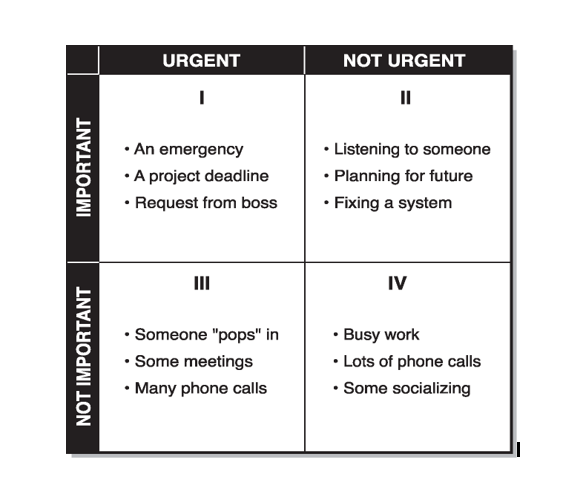Research tells us that 70-80% of leaders spend a good deal of their time in a reactive mode. You probably know what I mean. They’re down in the weeds, sometimes fighting fires or dealing with the crisis of the moment or handling day-to-day issues to keep an organization running smoothly. And, I get that some of this is necessary. But I also know that it’s easy to spend too much time in a reactive mode rather than doing what will add most value to your team or organization. So, I invite you to consider your leadership (management/supervision). Are you a reactive or proactive leader?
Time Management Matrix
Take a look at this time management matrix.
Take a look at quadrant I, urgent and important. It includes things like a real emergency, a big project deadline, a request from your boss. These are often things that can’t be put off.
Notice that quadrant II are matters that are not urgent and yet important. This can include things like taking time to listen to an employee (or child), visioning the future, or fixing a system.
Quadrant III is urgent and not important. Someone pops into your office. Lots of meetings and many phone calls. You may have a lot of these things during the day which keep you from being fully productive.
And quadrant IV includes things that are not important nor urgent such as busy work, scanning the internet, viewing social media, many phone calls, some socializing and so on.
Although you likely spend time in all four quadrants, it’s important, as a proactive leader, to be conscious of how you’re spending your time, the quadrant you’re in at any given time.
I want to emphasize the importance of quadrant II activities. This is the very meaning of proactive leadership. These activities result in long-term growth and development. They are how you make your organization stronger and your people more capable. And yet it is easy to put these activities off until another day.
The Team Model
Here’s a simple model to help you understand your leadership role. It is a way of stepping back to see the bigger picture. The model defines what’s most important for your team and thus clarifies your most important work as a leader. As you can see, there are three elements of the model.
The charter describes why a team or work group exists and includes such elements as your long-term vision, your purpose (or mission), values and goals.
The design describes how you organize to accomplish your charter. It includes defining your core work, roles and responsibilities, technical procedures, and systems that support your team in doing its work.
Relationships are about how people work together to accomplish their charter. It includes such things as trust and respect, cohesion and collaboration, communication, and management of conflict.
The model applies to any type of team or work group in any type or size of organization—a fast-food restaurant, call center, production line, dental or medical office, staff of a government agency, a professional services company, small retail business, church committee, or C-level leaders in a large corporation. It can even be applied to a family. The three elements make sense anytime you have a group of people who are interdependent and share a common mission.
Working “on” not “in” Systems
Edwards Demming was the father of the modern-day quality movement. He said that leaders should work “on” systems not “in” systems. This gets at proactive leadership. Working in a system is being caught up in the sequential events of the day or being swept up in the most urgent problems of the day. This is not where you add the most value.
You add most value when you’re working “on” systems which means that you’re strengthening or improving some elements of the team model rather than just fixing problems or facilitating the day-to-day work.
In fact, I’m going to suggest that if you spend too much time “in” the system it’s because one or more of the three elements of a team are broken or at least not working as they should. Working “on” the system is making sure that the three elements of the team model are working. And to refer back to the time management model, this is quadrant II work.
Leading from the Balcony
I call this leading from the balcony. Imagine that you are on a balcony and can observe everything that’s going on 
One thing I want to clarify is that you can be in the middle of the action and still be on the balcony. The balcony doesn’t represent physical space but rather a mindset. It’s a big picture view of what is happening no matter where you’re located or what you’re doing.
Let me clarify, a little further, what it means to lead from the balcony as a proactive leader.
• You’re mindful of the team model—charter, design and relationships—as you go about your day-to-day work
• You think about how to improve your charter, design or relationships
• You have a long-term perspective of whatever is happening
• You look for root causes of problems
• You fix a broken system rather than just solve the immediate problem
• You monitor the group climate
• You involve others in solving problems rather than doing it on your own
• You seek to build relationships with people to know how they’re doing
• You remain aware of the impact of your own actions on the group
And so on. This is far from a complete list. However, my point is that by leading from the balcony, you’re not simply thinking about day-to-day performance but are taking the long-view of your team’s ability to grow and contribute.
What is Your Product, as a Proactive Leader?
As a follow up to this last thought, what is your product when you think of yourself leading from the balcony? I want to suggest that it is not the same as the product or service your team provides to their customers. Of course, you do have ultimate accountability for this. But your product is improving the capability of your team. They will, in turn, be able to improve their work and provide a great service to their customers. It’s this perspective that’ll allow you to add the greatest value to your team and organization.
Asking the Right Questions
So, there are many ways you grow the capability of your team. However, I want to suggest that it begins with asking good questions. The purpose of these questions is to help you get out of the trenches, to increase your value and become a proactive leader by learning to work on systems rather than in systems. Not surprisingly, these questions have to do with the team model.
Charter
Let’s start with charter. Here are the kinds of questions you should ask yourself about your charter:
• How would I characterize the relationship between my team and their customers, whether internal or external?
• Do they understand their customer requirements and how these may be changing in the future?
• Does the team have a clear vision?
• Do they have a well-defined purpose statement?
• Do they share a common understanding of our team’s mission?
• Do they understand the strategy and mission of the larger organization?
• Do they know how they impact the organization’s strategy?
• Do we have well-defined values?
• Do I live our values and insist that others do as well?
• Do we have well-defined metrics?
• Are individual and team goals clear and how well do we communicate our progress?
Design
Here are some questions related to the design or organization of your team.
• Do my team members understand the core work processes of our team?
• Have we streamlined our processes to be as efficient as possible?
• Have we eliminated non-value adding steps?
• Does everyone know what is expected of them?
• How well have roles and responsibilities been defined?
• Are people technically competent at what they do?
• Do my employees understand not only their own jobs but how their jobs interrelate?
• Do people get the training they need to do their jobs?
• Do we offer training in business and social skills and well as technical skills?
• Are our work procedures clearly defined and do they help us coordinate our efforts?
• Does the team meet together as necessary to coordinate our work?
• Is it clear how we make decisions and who makes what decisions?
• Do we have systems in place (information-sharing, compensation, training, on-boarding, performance appraisals, etc.) to support us in accomplishing our work?
Relationships
Here are the kinds of questions I like to ask related to relationships.
• Do the members of my team care about the work they do?
• To what extent do I or other leaders share information with them about what’s going on with the company or changes that might impact their jobs?
• How positive and friendly is the atmosphere among people on our team?
• Do people collaborate?
• Do they show trust and respect for one another?
• Do they know that their work makes a difference?
• How much support do my people feel from me?
• Do they come to me with concerns and know that I’ll listen?
• Do I coach them and help them grow and develop?
• Do people listen to each other and does everyone feel free to express themselves?
• Do people sense that they’ll be treated fairly?
• How well do we work through conflicts and arrive at win-win solutions?
• Are our personnel policies and procedures fair and equitable?
I want you to know that this is a sampling but not complete set of questions in these three areas. You can come up with more appropriate questions for your team based on the nature of your work and circumstances. The important point is that such questions illustrate the way proactive leaders think and offer them a way of better defining the value they bring to their teams.
Conclusion and Application
I want to conclude by saying that it is a challenge to spend less time reacting to day-to-day events and more time as a proactive leader. My hope is that the team model and idea of leading from the balcony have given you a conceptual framework for doing this.
Consider and even jot down your thoughts. How does your understanding of the team model influence your thinking about your role as leader? And, can you think of some ways you can spend less time in the trenches (being reactive) and instead lead from the balcony?
If you have found these ideas useful, I have just launched a new video course on Udemy entitled Leadership to Engage Hearts and Minds: 17 Tools to Improve Your Team Management and Build Employee Engagement.
Furthermore, I want to give you, my subscribers who have interest in this topic, a free enrollment into the course (regular price is $99.99). It’s my way of saying “thanks” for being a regular reader of my blog. Click here for your free enrollment. And be aware that it will expire after three days, (Sunday, June 28 at 7:30 a.m. MDT).



Thank you Roger for your generosity in offering free enrolment in this course. It’s much appreciated.
I completed your course on Claiming your Power to Live a Happy and Abundant Life last year, and it changed my life. Thanks again.
You’re welcome, Suzy. I’m happy to know that my Claiming Your Power Course made such a difference to you.
Roger